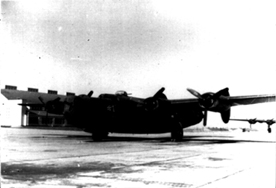 |
Information about The B-24 Liberator |
| The United States Army Air Corps requested the Consolidated Aircraft Company to design a new Heavy bomber that would exceed the current capabilities of the B-17 "Flying Fortress" in 1938. As a result of this request, the high winged, four engine B-24 was born. The B-24 had twin vertical stabilizers and high lift Davis wings, and was so promising, that the Army Air Corps ordered 7 prototypes before the first was even built. The Army Air Corps then ordered 38 production models before the first prototype ever hit the air.
The B-24 had different models. They ranged from the A model through the M model. The biggest changes in design came with the B-24C, which added top and tail turrets. The B-24G saw the addition of a power turret that replaced the twin handheld .50 caliber machine guns that were located in the nose. The B-24J was the model that was produced in the largest quantity. Of the 18,188 B-24 Liberators built, 6,678 were J's. While the Liberator lacked the capability of withstanding the enemy fire that the Flying Fortress had, it did what it was designed to do - it took the war to the Axis Powers with a larger bomb load, greater speed and farther range then the Flying Fortress had. Consolidated B-24H "Liberator" The B-24H was the result of a design effort to improve the defensive firepower of the basic B-24D design. Combat experience showed even the late model B-24Ds with three nose mounted .50-cal. machine guns were vulnerable to head-on attacks. Some B-24Ds had power nose turrets (modified Emerson A-6 tail turrets) added at depot facilities and had greater success fending off frontal assaults. The Army Air Force wanted this improvement incorporated into the B-24s coming off the production lines, so Emerson and Consolidated engineers redesigned the aircraft to accept the turret. The results were sent to the Ford Willow Run plant for manufacture. The nose turret addition required more than 50 airframe changes including a new bombardier compartment. Other improvements incorporated to improve the defensive strength of the aircraft included a new tail turret design with larger plexiglass windows, a higher top turret bubble for increased visibility and offset waist gunner positions (starting with block 20 aircraft) to prevent the waist gunners from interfering with each other in battle. The -H model design was sent to North American which built it as the B-24G-1. Ford also sent B-24H subassemblies to Consolidated and Douglas for final assembly.
Notes:
Specs of the B-24 Liberator:
Crew: 10 (pilot, co-pilot, navigator, bombardier, engineer, radio operator, 4 gunners)
|
This Page was last updated on June 8, 2000 |